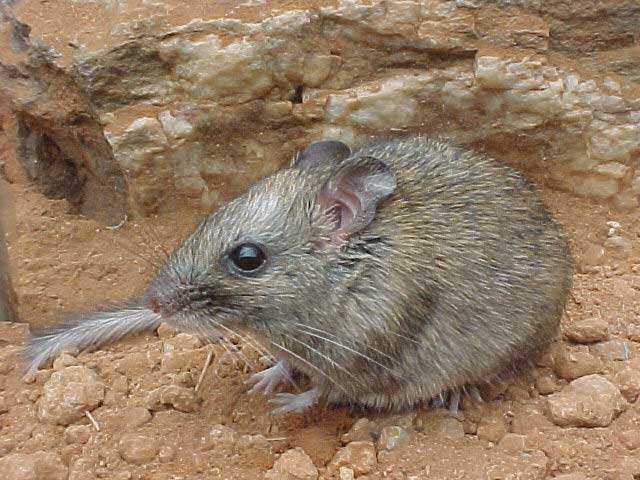
Zyzomys pedunculatus, Photo: Michael Barritt & Karen May
Superregnum: Eukaryota
Cladus: Unikonta
Cladus: Opisthokonta
Cladus: Holozoa
Regnum: Animalia
Subregnum: Eumetazoa
Cladus: Bilateria
Cladus: Nephrozoa
Superphylum: Deuterostomia
Phylum: Chordata
Subphylum: Vertebrata
Infraphylum: Gnathostomata
Megaclassis: Osteichthyes
Cladus: Sarcopterygii
Cladus: Rhipidistia
Cladus: Tetrapodomorpha
Cladus: Eotetrapodiformes
Cladus: Elpistostegalia
Superclassis: Tetrapoda
Cladus: Reptiliomorpha
Cladus: Amniota
Cladus: Synapsida
Cladus: Eupelycosauria
Cladus: Sphenacodontia
Cladus: Sphenacodontoidea
Cladus: <a href="../Synapsida/Therapsida.html">Therapsida</a>identified from photographs as the central rock-rat. Since that time sub-populations have been found at 15 other sites over a small area of the West MacDonnell Ranges. The full range of the current distribution of the species is unknown.[10]
The Central rock rat has a national recovery plan through the Australian government, its overall objective being to stabilize the species and prevent population decreases. Specific objectives include: clarifying distribution, population size, and habitat; to create and employ management strategies of the sub-populations; maintaining captive populations; investigating the biology of captive individuals; and to increase awareness in the community. Recovery actions include establishing the sizes of sub-populations and monitoring changes in them, creating a fire strategy for known population locations, and capturing animals to add to the captive breeding program. The recovery plan also has a provision for habitat protection which would help other native species such as the common brushtail possum and the black-footed rock wallaby.[10] Beginning in 1996, after the re-discovery of the central rock-rat, a captive breeding program was set up at Alice Springs Desert Park and at the Perth Zoo. After initially introducing 14 individuals from the wild, the first generation bred successfully but the subsequent one had significant trouble, eventually leading to the death of the last male in 2011.[18] The National Recovery Plan for the Central Rock-rat in 2017 suggested to attempt another breeding program during a natural irruption phase of the wild population, for example after the heavy rainfall in the winter of 2016, so as to limit the effects on the wild numbers of the species.[19]
References
Woinarski, J.; Burbidge, A.A. (2016). "Zyzomys pedunculatus". IUCN Red List of Threatened Species. 2016: e.T23324A22456932. doi:10.2305/IUCN.UK.2016-1.RLTS.T23324A22456932.en. Retrieved 11 November 2021.
"Appendices | CITES". cites.org. Retrieved 2022-01-14.
Central Rock Rat Archived October 18, 2014, at the Wayback Machine. earthsendangered.com
McDonald, P. J.; Pavey, C. R.; Knights, K.; Grantham, D.; Ward, S. J.; Nano, C. E. M. (2013). "Extant population of the Critically Endangered central rock-rat Zyzomys pedunculatus located in the Northern territory, Australia". Oryx. 47 (2): 303. doi:10.1017/S0030605313000136.
Kissel, Anthea (11 June 2010). "Scientist discover rock rat in central Australia". ABC Radio Australia News. Australian Broadcasting Corporation. Retrieved 11 June 2010.
"Rock rat not so extinct after all". NineNews. Ninemsn. 6 September 2013. Archived from the original on 2013-09-09. Retrieved 6 September 2013.
"Central Rock Rat". Archived from the original on 2013-09-17. Retrieved October 23, 2013.
Central Rock Rat. Animal Info
Central Rock Rat. ruralheli.com.au
Cole, Jeff (2000) National recovery plan for the Central Rock-rat (Zyzomys pedunculatus). Parks and Wildlife Commission of the Northern Territory, Environment Australia
Gaikhorst, G.; Lambert, C. (2009). "Breeding and maintenance of the Central rock-rat Zyzomys pedunculatus at Perth Zoo". International Zoo Yearbook. 43: 212–221. doi:10.1111/j.1748-1090.2008.00075.x.
Gaikhorst, G.; C. Lambert (24 Dec 2008). "Breeding and maintenance of the Central rock-rat Zyzomys pedunculatus at Perth Zoo". International Zoo Yearbook. 43: 212–221. doi:10.1111/j.1748-1090.2008.00075.x.
Nano, Theresa J.; Smith, Cate M.; Jefferys, Elizabeth (2003). "Investigation into the diet of the central rock-rat (Zyzomys pedunculatus)". Wildlife Research. 30 (5): 513–518. doi:10.1071/wr01084.
Nano, T. J.; Smith, C. M.; Jefferys, E. (2003). "Investigation into the diet of the central rock-rat (Zyzomys pedunculatus)". Wildlife Research. 30 (5): 513. doi:10.1071/WR01084.
Old, J. M.; Connelly, L.; Francis, J.; Branch, K.; Fry, G.; Deane, E. M. (2005). "Haematology and serum biochemistry of three Australian desert murids: The Plains rat (Pseudomys australis), the Spinifex hopping-mouse (Notomys alexis) and the Central rock-rat (Zyzomys pedunculatus)". Comparative Clinical Pathology. 14 (3): 130. doi:10.1007/s00580-005-0586-y.
"Rock Rat discovered in central Australia". Australian Associated Press. Retrieved October 23, 2013.
Fry, Gary. Central rock-rat (Zyzomys pedunculatus) Archived 2013-10-29 at the Wayback Machine. arkive.org
McDonald, P; Ward, S; Nano, C; Pavey, C; Nano, T; Nunn, Peter (2017). "National Recovery Plan for the Central Rock-rat Zyzomys pedunculatus; APPENDIX 2: SUMMARY AND REVIEW OF THE CAPTIVE BREEDING PROGRAM 1996-2011". Northern Territory Dept. of Environment and Natural Resources. Alice Springs, Northern Territory. p. 49. Retrieved 3 April 2018.[dead link]
McDonald, P; Ward, S; Nano, C; Pavey, C; Nano, T; Nunn, P (2017). "National Recovery Plan for the Central Rock-rat Zyzomys pedunculatus; 2.7 Captive breeding". Northern Territory Dept. of Environment and Natural Resources. Alice Springs, Northern Territory. p. 17. Retrieved 3 April 2018.
Retrieved from "http://en.wikipedia.org/"
All text is available under the terms of the GNU Free Documentation License

